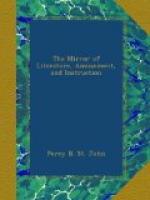* * * * *
CONFESSION OF THE EXECUTIONER OF CHARLES I.
There have been great disputes about the person who beheaded Charles I. Mr. Ellis says, “it seems most probable that the person who actually beheaded the king was the common executioner.” And then adds the following valuable and interesting note, which seems to us to settle the question.
“Among the tracts relating to the civil war, which were given to the British Museum by his late majesty King George III. in 1762, there are three upon this subject. One is entitled, ’The Confession of Richard Brandon the Hangman (upon his death-bed), concerning his beheading his late Majesty. Printed in the year of the hangman’s downfall, 1649.’ The second is entitled, ‘The last Will and Testament of Richard Brandon,’ printed in the same year. The third is, ’A Dialogue or Dispute between the late Hangman (the same person), and Death,’ in verse, without date. All three are in quarto.”
The following are the most important paragraphs of the first tract:
“The confession of the hangman concerning his beheading his late majesty the king of Great Britain (upon his death-bed) who was buried on Thursday last in Whitechapel church-yard, with the manner thereof:—
“Upon Wednesday last (being the 20th of this instant, June 1649), Richard Brandon, the late executioner and hangman, who beheaded his late majesty, king of Great Britain, departed this life; but during the time of his sicknesse his conscience was much troubled, and exceedingly perplexed in mind, yet little shew of repentance for remission of his sins, and by past transgressions, which had so much power and influence upon him, that he seemed to live in them, and they in him. And on Sunday last, a young man of his




